Updated January 15, 2018
County health briefs offer comprehensive information about Tennessee cities and their surrounding areas. Each county health brief is different and focuses on that county’s biggest health challenges as identified by county and city health departments. Due to the highly customized nature of this information, statistics and metrics will vary from brief to brief.
The Memphis and Shelby County health brief focuses on the top health priorities as identified by local experts. Many elements are included in Shelby County’s community health assessment and community health improvement plan.
Scroll down to read about health in Shelby County or jump to a specific section:
What are the demographics of Shelby County?
Population
Nearly 1 million
Density: 1,215 people per square mile
Population growth: Peaked in 2012 and has been declining slightly since
Shelby County population growth 2000-17
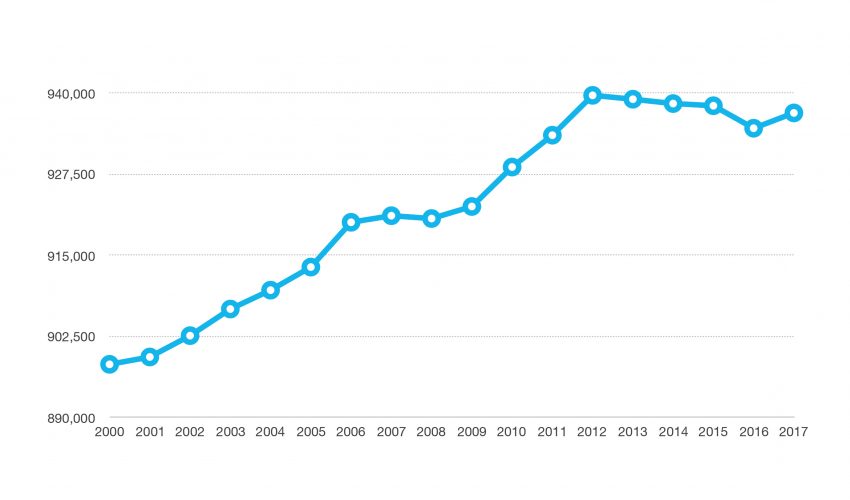
U.S. Census Bureau estimates of the number of people living in Shelby County from 2000-2017.
Age
The median age in Shelby County is 35.

Sex
Female: 52%
Male: 48%
Race
Black: 52%
White: 41%
Hispanic: 6%
Multiple: 1%
Tennessee’s Hispanic population growth rate is the 3rd highest in the nation.
Life expectancy
76 years
This is comparable to Tennessee’s life expectancy but below the 78-year life expectancy for the U.S. as a whole.
Several ZIP codes on the western side of Memphis experience life expectancies as low as 70 years.
Life expectancy in years
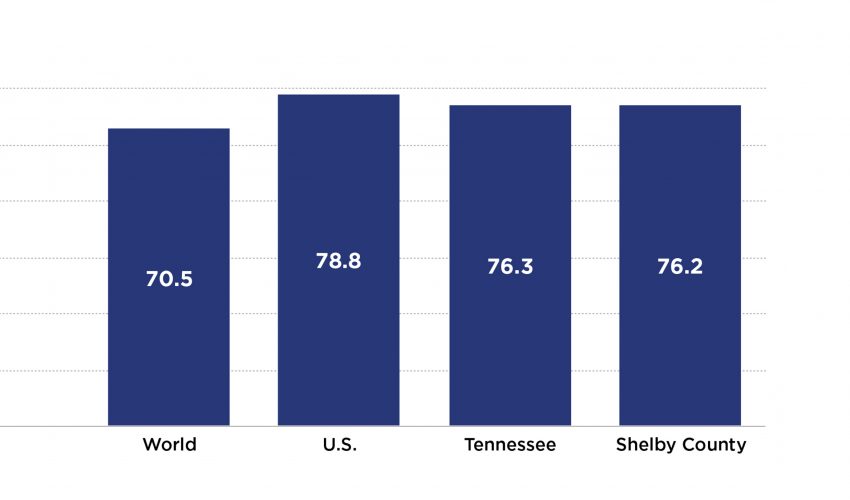
Health index
Shelby County scores 0.909 out of 1.0 in the BlueCross Health Index, compared to a 0.907 statewide average. The index is based on a scale in which 0.867 is less healthy and 0.970 is more healthy.
The index measures the impact of more than 200 common diseases and conditions on overall health and wellness by assigning each county in the United States a health metric between 0 and 1, designating the proportion of optimal health reached by the county’s population. For example, a measurement of 0.9 indicates that, on average, the population of a county is living at 90% of its optimal health. In other words, the county population could gain up to 10% in healthy lifespan by addressing the top health conditions impacting their area.
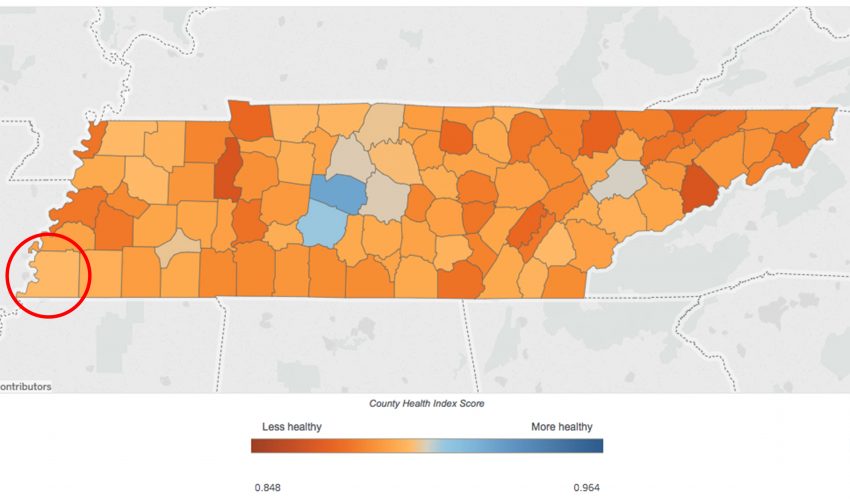
What are the most common causes of death in Shelby County?
Chronic diseases such as heart disease, cancer and diabetes account for 6 of the 10 leading causes of death in Shelby County.
The top 10 causes of death are:
- Heart disease
- Cancer (malignant neoplasms)
- Injury
- Stroke
- Alzheimer’s Disease
- Chronic lower respiratory disease
- Diabetes
- Flu/pneumonia
- Homicide
- Blood poisoning (septicemia)
Leading causes of death in Shelby County, 2015
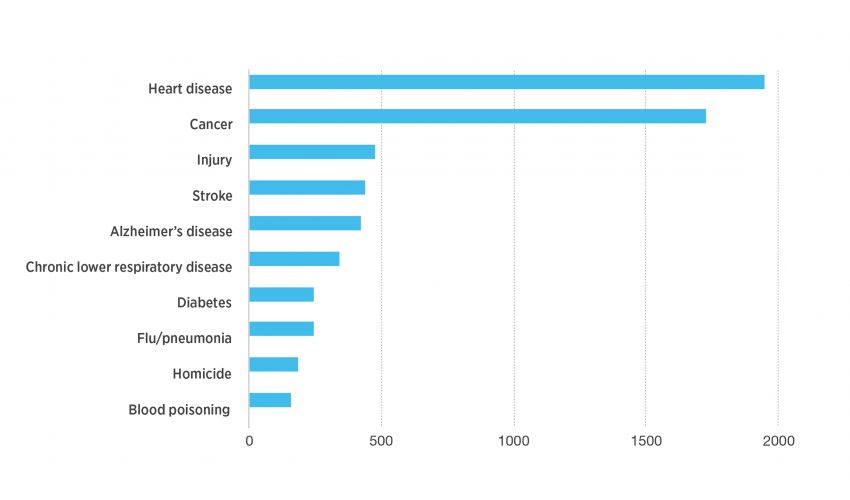
What are the most common diseases in Shelby County?
Heart disease and cancer are the most common chronic diseases in Shelby County.
Chronic diseases
- Heart disease
- Cancer
- Diabetes
- Asthma
- Hypertension
- High cholesterol
- Coronary artery disease
Heart disease
The rate of heart disease in Shelby County is 177 per every 100,000 people, which is comparable to the rate in Tennessee (175.5) and higher than the U.S. rate (134).
There are many contributing factors to heart disease. In Shelby County, high obesity and diabetes rates are of particular concern.
Obesity
7 of 10 residents are overweight.
33% of people in Shelby County are obese compared to:
- 31% of Tennesseans, and
- 40% of Americans
For every 100,000 people in Shelby County there are:
- 73 fast food restaurants but only
- 20 grocery stores
More people in Shelby County live within a half-mile of a park than in Tennessee or the U.S.
Diabetes
1 in every 3 adults (110,000) in Shelby County has diabetes.
60,000 new cases have been reported over 10 years.
An average of 1 person dies every day from diabetes in Shelby County. [2012-14]
- Diabetes is the 7th leading cause of death in Shelby County
- 67% of people who died from diabetes in Shelby County were black
The mortality rate for diabetes is:
- 16% of whites
- 44% of blacks
Diagnosed diabetes prevalence trends
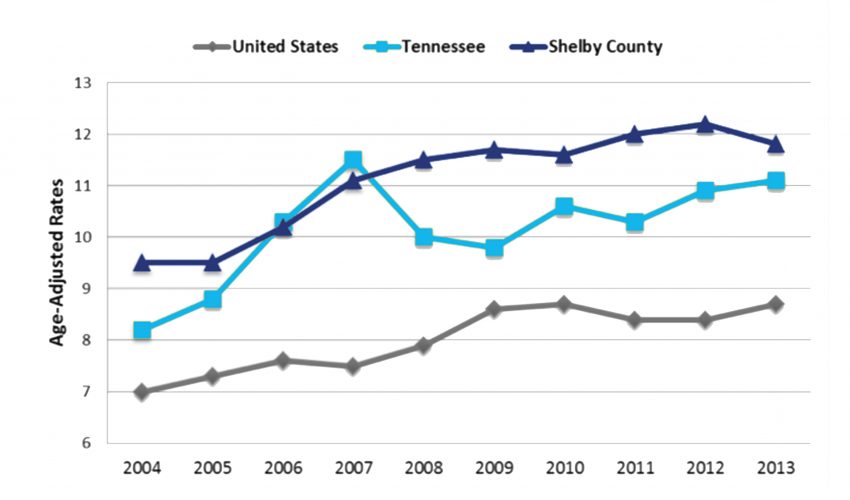
Cancer
Breast, cervical, colon and prostate cancer are more common in Shelby County than in the rest of the state. Lung cancer is less common.
Addiction
The top 3 substances that are abused in Tennessee are:
- Alcohol
- Opioids
- Marijuana
Alcohol
Heavy consumption of alcohol is higher in Shelby County (11.7%) than Tennessee (8.5%) but lower than the U.S. (15%).
Opioids
1 in 6 Tennesseans misuses or abuses opioids or is in treatment.
Opioid use is lower in Shelby County than in other parts of the state, however overdose deaths involving opioids, fentanyl and heroin have all increased in recent years.
Smoking
In 2015, Shelby County residents spent approximately $222 million on cigarettes.
38% of survey respondents were former or current smokers, which is lower than:
- 46% of Tennesseans, and
- 43% of people living in the U.S.
Alzheimer’s Disease
Alzheimer’s Disease is the 5th leading cause of death in Shelby County and the 6th leading cause in the U.S.
Allergies
Memphis was ranked #2 in metropolitan areas where pollen sufferers find it challenging to live due to high pollen counts.
Infectious Diseases
HIV
New cases of HIV have decreased in Shelby County in recent years, but with 275 new cases diagnosed annually, it is still a public health issue.
Shelby County’s rate of new cases of HIV is 3X the state of Tennessee’s rate.
Of the people living with HIV/AIDS in Memphis:
- 31% are women
- 69% are men
Number of cases of HIV, Shelby County, 2005-15
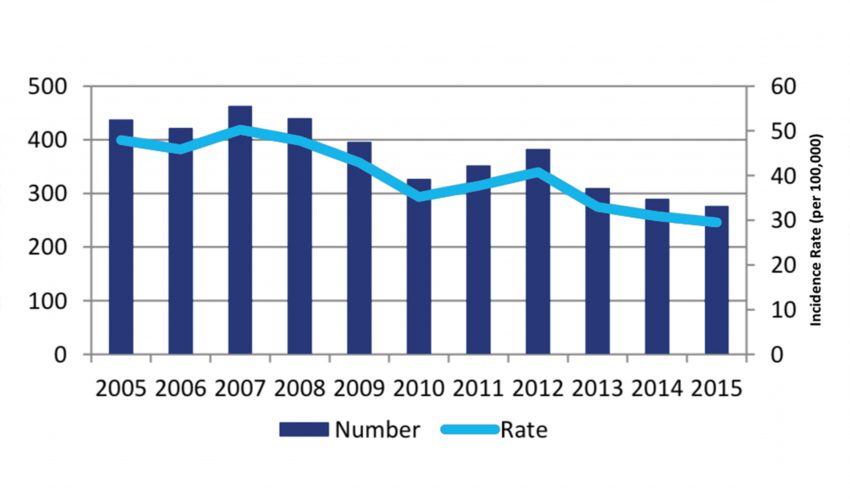
Flu
Nearly 70% of people in Shelby County and Tennessee who are 65+ receive the flu vaccine, which is higher than the national rate of 60%.
Lead exposure
Lead exposure affects the central nervous system and can have lifelong effects (lowered IQ, learning disabilities, behavioral problems).
While the rate of lead exposure has decreased in Shelby County, it is still a serious problem. The county screens and treats children in high-risk areas.
Air & water quality
Most of Shelby County has better than average air and water quality. Public drinking water is considered above average in quality as Shelby County water is drawn from the Memphis Sand aquifer, which has a natural filtration system that sifts out impurities.
Other diseases
In recent years in Shelby County:
- Strep, flu, and bacterial meningitis infections increased
- Pertussis, bacterial infections, E. coli, and Shigellosis infections decreased
- There were no cases of measles, mumps, rubella, or diphtheria
What social determinants and health disparities affect Shelby County?
Health disparities are differences in health outcomes of distinct groups of people. They negatively affect groups who have experienced greater social or economic obstacles to health.
Social determinants
Social determinants of health include all circumstances in which people are born, live, learn, age, etc. that affect their health and quality of life.

Graphic adapted from the Shelby County community health improvement plan
Economic Hardship Index (EHI)
Where you live affects your health. Social determinants of health are mostly responsible for health disparities: unfair and avoidable differences in health status of different groups.
The EHI focuses on 6 key social determinants:
- Unemployment
- Dependency
- Education
- Income
- Crowded housing
- Poverty
The EHI Score ranges from 0 to 100. A higher score indicates greater economic hardship.
Economic Hardship Index, Shelby County, 2011-2015
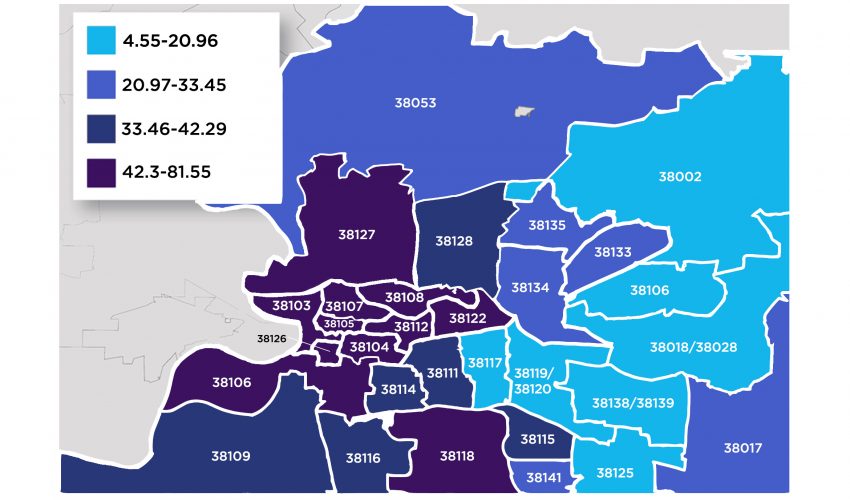
Dependency
Dependency refers to the number of people who are under 18 or over 65. These people often must be cared for by others, which affects economic and health outcomes.
In Shelby County, nearly 40% of the population are dependents (375,000 people).
Infant mortality
Infant mortality is the number of children out of every 1,000 live births who die before turning one. In Shelby County, infant mortality decreased from 9.6 to 8.2 in 2015.
This is the lowest infant mortality rate ever recorded in Shelby County.
Racial disparities persist. Blacks experience the highest infant mortality rates in Shelby County — more than 2X that of whites.
Infant mortality rates, Shelby County, 2003-15

Premature birth
The preterm birth rate is 12.5% in Shelby County (1,676 babies). The rate has remained relatively steady since 2007.
Low birth weight
11% of babies in Shelby County are born with low birth weight.
- This is higher than the national average of 8%.
More than half of children in Shelby County live in single-parent households.
- 51.6% are two-parent households
- 42.2% are mother-only, and
- 6.4% are father-only.
23,000 grandparents in Shelby County have one or more of their grandchildren living with them. Half serve as the grandchild’s primary caretaker or guardian.
Of households in Shelby County:
- 51.6% are two-parent households
- 42.2% are mother-only, and
- 6.4% are father-only.
Teen pregnancy
Teen pregnancy has been steadily decreasing since 2007 in an overall decline of 41%.
The rate in Shelby County is still higher than that of the U.S.:
- Shelby County: 49 per 1,000 births
- U.S.: 37
The teen pregnancy rate in Shelby County reached a historic low in 2015 of 38.6.
Neglect
The rate of substantiated child abuse neglect charges in Shelby County is lower than the rate in Tennessee and the U.S.
Education
The number of people who have completed high school in Shelby County is 85.6%. That is:
- Comparable with the U.S. rate of 85.4% and
- Better than the statewide rate of 83.2%.
Income
The median income in Shelby County is $44,051, which is
- Higher than Tennessee’s ($41,691) and
- Lower than the U.S. ($51,413).
Wealth disparity has not improved in 50 years.
In 2016, black median household income in Memphis was only 58% of local white income.
Poverty
30% of children in Shelby County live below the poverty line. That is higher than:
- Tennessee’s rate of 24% and
- The national rate of 20%.
In the U.S., the federal poverty line (FPL) for a family of four is $23,550. The percentage of children in Shelby County living in poverty has increased over time and is driven largely by more children living in extreme poverty — those below 50 percent of the FPL.
Where the poor live, Shelby County, children under 6, 2008-12
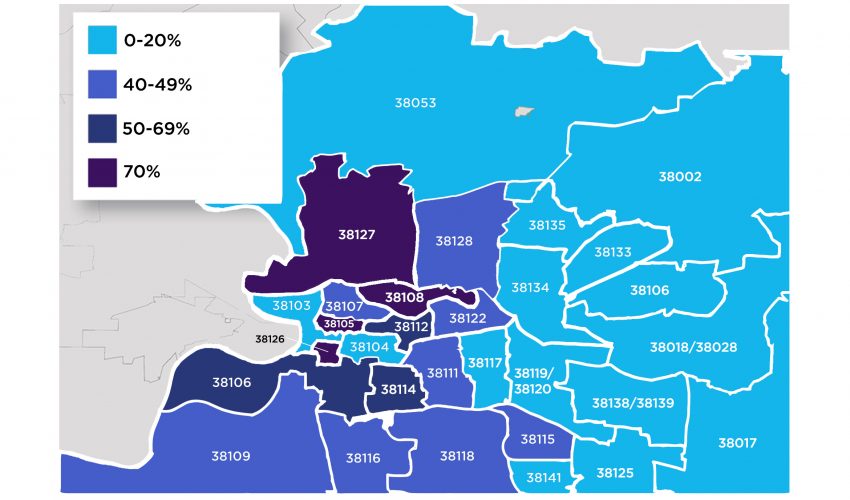
Shelby County children under 6 living in poverty from U.S. census bureau
ZIP codes
In the 38126 ZIP code, 6 of every 10 people live in poverty.
- For children, that increases to nearly 8 in 10.
In the 1990s, a study of Memphis found vast differences across the city. In certain ZIP codes, the average income was less than $5,000 per year, compared to 13 miles away where the income was $80,000.
Food
The percent of people receiving nutrition assistance benefits is higher:
- In Shelby County (28%) than it is in
- Tennessee (20%) or
- The U.S. (14.5%).
31% of the population has difficulty accessing or affording food, which is higher than Tennessee’s rate of 27%. Many ZIP codes in the Memphis area are considered food deserts.
Crime
Shelby County’s violent crime rate is higher than Tennessee’s rate and higher than the national benchmark.
Out of every 100,000 people, the number who experience violent crime is:
- Shelby County: 1,377
- Tennessee: 667
- U.S.: 66
The homicide rate out of 100,000 is also higher in Shelby County (17) than statewide (8). Memphis routinely ranks in the top 10 cities with the highest crime rates in the nation.
- 67% of survey respondents in Shelby County felt crime and violence were major problems in their community
- 58% feel their community is an unsafe place to live
Domestic violence
The domestic violence rate in Shelby County is 2,949 per 100,000 people, which is more than 2X the rate in Tennessee (1,323).
Youth violence
In some areas of Memphis, the youth homicide rate is as high as 690 for every 100,000 youth.
Access to health care
The ratio of the Shelby County population to medical providers is lower than Tennessee but higher than the national benchmark.
Mental health & depression
The population to mental health provider rate in Shelby County is lower than Tennessee’s rate. There is only 1 mental health provider for every 2,229 people.
- 1 in 5 people in Shelby County report inadequate social support
- 13% felt they needed mental health care in the last 12 months but did not receive it
- 25% felt suicide is a topic that needs attention in their community

The Church Health Center offers health care to Memphians in need.
Health disparities
Race
In Shelby County, blacks die from these conditions at least 2X as much as whites:
- Heart disease
- Diabetes
- Stroke
- Homicide
- HIV
White people die more frequently from:
- Chronic lower respiratory diseases
- Alzheimer’s Disease
- Suicide
Black people are 3X more likely to die from HIV/AIDs than white people. White people are 2X as likely to die from suicide.
How is Shelby County addressing health challenges?
In 2012, the Shelby County Health Department spearheaded efforts to create a community health profile for Shelby County.
They identified 5 focus areas:
- Health disparities and social determinants
- Communication, coordination and collaboration within the public health system
- Mental health, specifically depression
- Healthy lifestyles (nutrition, active living, diabetes)
- Violence as a public health issue, specifically youth violence prevention
From that came a community-driven plan for improving population health outcomes. Click here to download that plan.
What has BlueCross done for health in Shelby County?
BlueCross BlueShield of Tennessee provides health coverage, care coordination services and health management tools to hundreds of thousands of members in the Memphis area.
In addition to bringing peace of mind to those members, the BlueCross BlueShield Health Foundation has invested in the area’s overall health by:
- Committing up to $5.4 million to revitalize David Carnes Park as a BlueCross Healthy Place for residents of all ages to be physically active
- Giving $3 million to make GoNoodle available to elementary schools in Tennessee. Memphis students have logged 10 million+ minutes of active learning with GoNoodle
- Investing $1.7 million to transform outdoor spaces into places where people can get fit, including RiverFit in Memphis
- Awarding the Sickle Cell Center a $150,000 grant toward startup of a clinic
- Granting $150,000 to the Medical Education & Research Institute for simulation training for medical professionals
- Giving $100,000 to the Women’s Foundation of Greater Memphis to launch an ambassador program to reduce poverty by 5%
- Donating $100,000 to Tennessee food banks over the last 5 years
- Awarding the Orpheum a $55,000 grant for Mending Hearts Camp, where children heal after the death of a parent
- Supporting Latino Memphis with $50,000
- Giving $50,000 to Hope Lodge for support of cancer patients
- Supporting childhood nutrition with $6,000 to Porter-Leath
- Giving $5,000 to support The Kitchen Community in Memphis
Stories from Shelby County

The BlueCross Healthy Place program is revitalizing David Carnes Park in Memphis. Click the rendering to learn more.

Click the graphic above to read about minority health in Memphis and Tennessee with BlueCross's Rafielle Freeman.

Porter-Leath Spoonfuls program helps childcare providers give kids nutritious meals. Click to read their story.

In Memphis’s poorest neighborhood, women work to achieve sustainable self-sufficiency. Click the image to read their success story.

Cancer patients find support and a family of fellow survivors at Hope Lodge in Memphis. Click the image to read more.

At Mending Hearts Camp, the arts serve as a turning point for youths mourning a parent. Click the image to read more.



